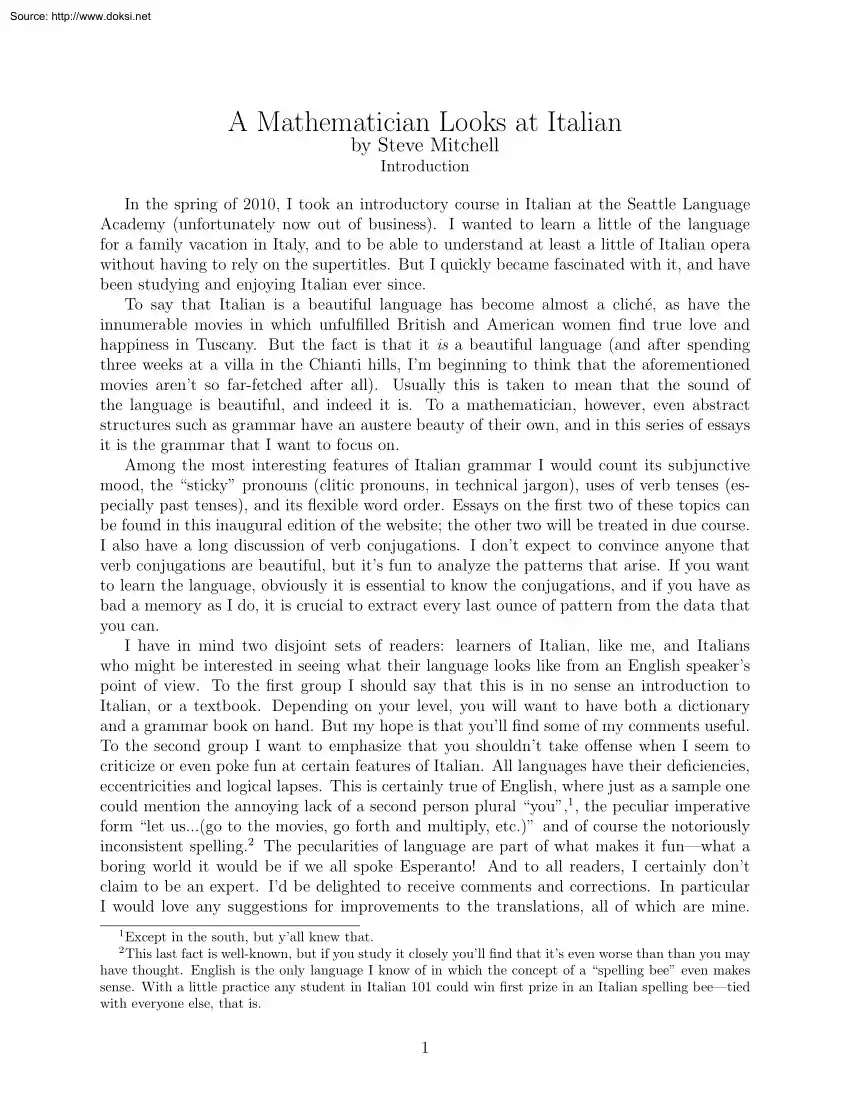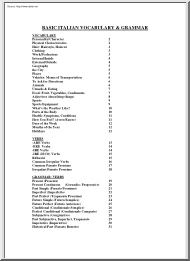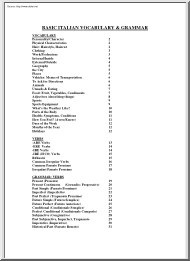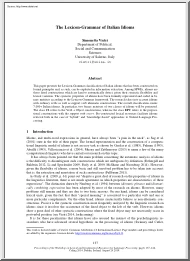Datasheet
Year, pagecount:2014, 2 page(s)
Language:English
Downloads:2
Uploaded:February 01, 2018
Size:524 KB
Institution:
-
Comments:
Attachment:-
Download in PDF:Please log in!
Comments
No comments yet. You can be the first!Content extract
Source: http://www.doksinet A Mathematician Looks at Italian by Steve Mitchell Introduction In the spring of 2010, I took an introductory course in Italian at the Seattle Language Academy (unfortunately now out of business). I wanted to learn a little of the language for a family vacation in Italy, and to be able to understand at least a little of Italian opera without having to rely on the supertitles. But I quickly became fascinated with it, and have been studying and enjoying Italian ever since. To say that Italian is a beautiful language has become almost a cliché, as have the innumerable movies in which unfulfilled British and American women find true love and happiness in Tuscany. But the fact is that it is a beautiful language (and after spending three weeks at a villa in the Chianti hills, I’m beginning to think that the aforementioned movies aren’t so far-fetched after all). Usually this is taken to mean that the sound of the language is beautiful, and indeed it is. To
a mathematician, however, even abstract structures such as grammar have an austere beauty of their own, and in this series of essays it is the grammar that I want to focus on. Among the most interesting features of Italian grammar I would count its subjunctive mood, the “sticky” pronouns (clitic pronouns, in technical jargon), uses of verb tenses (especially past tenses), and its flexible word order. Essays on the first two of these topics can be found in this inaugural edition of the website; the other two will be treated in due course. I also have a long discussion of verb conjugations. I don’t expect to convince anyone that verb conjugations are beautiful, but it’s fun to analyze the patterns that arise. If you want to learn the language, obviously it is essential to know the conjugations, and if you have as bad a memory as I do, it is crucial to extract every last ounce of pattern from the data that you can. I have in mind two disjoint sets of readers: learners of Italian,
like me, and Italians who might be interested in seeing what their language looks like from an English speaker’s point of view. To the first group I should say that this is in no sense an introduction to Italian, or a textbook. Depending on your level, you will want to have both a dictionary and a grammar book on hand. But my hope is that you’ll find some of my comments useful To the second group I want to emphasize that you shouldn’t take offense when I seem to criticize or even poke fun at certain features of Italian. All languages have their deficiencies, eccentricities and logical lapses. This is certainly true of English, where just as a sample one could mention the annoying lack of a second person plural “you”,1 , the peculiar imperative form “let us.(go to the movies, go forth and multiply, etc)” and of course the notoriously inconsistent spelling.2 The pecularities of language are part of what makes it funwhat a boring world it would be if we all spoke Esperanto!
And to all readers, I certainly don’t claim to be an expert. I’d be delighted to receive comments and corrections In particular I would love any suggestions for improvements to the translations, all of which are mine. 1 Except in the south, but y’all knew that. This last fact is well-known, but if you study it closely you’ll find that it’s even worse than than you may have thought. English is the only language I know of in which the concept of a “spelling bee” even makes sense. With a little practice any student in Italian 101 could win first prize in an Italian spelling beetied with everyone else, that is. 2 1 Source: http://www.doksinet Although I do use some textbook examples, most of the examples are taken from Italian novels (the particular choice of novel usually depending on what I happened to be reading at the moment). Acknowledgement (updated March 2014): I’d like to take this opportunity to thank my six Italian teachers to date, all of whom have been
fabulous. In the order that I’ve studied with them, they are: Jenny Allen, Francesca Giambartolomei, Marc Mariani, Roberta Torgerson, Elisabetta Valentini, and Lia Fichera. I especially want to thank Percorso Italianothat is, Roberta, Elisabetta and Liafor providing such a warm and welcoming environment in which to study their beautiful language, and above all Elisabetta who was my absolutely amazing teacher from January 2011 to June 2013. It should go without saying, however, that any mistakes, misconceptions and other nonsense in these essays are my responsibility alone. 2
a mathematician, however, even abstract structures such as grammar have an austere beauty of their own, and in this series of essays it is the grammar that I want to focus on. Among the most interesting features of Italian grammar I would count its subjunctive mood, the “sticky” pronouns (clitic pronouns, in technical jargon), uses of verb tenses (especially past tenses), and its flexible word order. Essays on the first two of these topics can be found in this inaugural edition of the website; the other two will be treated in due course. I also have a long discussion of verb conjugations. I don’t expect to convince anyone that verb conjugations are beautiful, but it’s fun to analyze the patterns that arise. If you want to learn the language, obviously it is essential to know the conjugations, and if you have as bad a memory as I do, it is crucial to extract every last ounce of pattern from the data that you can. I have in mind two disjoint sets of readers: learners of Italian,
like me, and Italians who might be interested in seeing what their language looks like from an English speaker’s point of view. To the first group I should say that this is in no sense an introduction to Italian, or a textbook. Depending on your level, you will want to have both a dictionary and a grammar book on hand. But my hope is that you’ll find some of my comments useful To the second group I want to emphasize that you shouldn’t take offense when I seem to criticize or even poke fun at certain features of Italian. All languages have their deficiencies, eccentricities and logical lapses. This is certainly true of English, where just as a sample one could mention the annoying lack of a second person plural “you”,1 , the peculiar imperative form “let us.(go to the movies, go forth and multiply, etc)” and of course the notoriously inconsistent spelling.2 The pecularities of language are part of what makes it funwhat a boring world it would be if we all spoke Esperanto!
And to all readers, I certainly don’t claim to be an expert. I’d be delighted to receive comments and corrections In particular I would love any suggestions for improvements to the translations, all of which are mine. 1 Except in the south, but y’all knew that. This last fact is well-known, but if you study it closely you’ll find that it’s even worse than than you may have thought. English is the only language I know of in which the concept of a “spelling bee” even makes sense. With a little practice any student in Italian 101 could win first prize in an Italian spelling beetied with everyone else, that is. 2 1 Source: http://www.doksinet Although I do use some textbook examples, most of the examples are taken from Italian novels (the particular choice of novel usually depending on what I happened to be reading at the moment). Acknowledgement (updated March 2014): I’d like to take this opportunity to thank my six Italian teachers to date, all of whom have been
fabulous. In the order that I’ve studied with them, they are: Jenny Allen, Francesca Giambartolomei, Marc Mariani, Roberta Torgerson, Elisabetta Valentini, and Lia Fichera. I especially want to thank Percorso Italianothat is, Roberta, Elisabetta and Liafor providing such a warm and welcoming environment in which to study their beautiful language, and above all Elisabetta who was my absolutely amazing teacher from January 2011 to June 2013. It should go without saying, however, that any mistakes, misconceptions and other nonsense in these essays are my responsibility alone. 2





 Just like you draw up a plan when you’re going to war, building a house, or even going on vacation, you need to draw up a plan for your business. This tutorial will help you to clearly see where you are and make it possible to understand where you’re going.
Just like you draw up a plan when you’re going to war, building a house, or even going on vacation, you need to draw up a plan for your business. This tutorial will help you to clearly see where you are and make it possible to understand where you’re going.